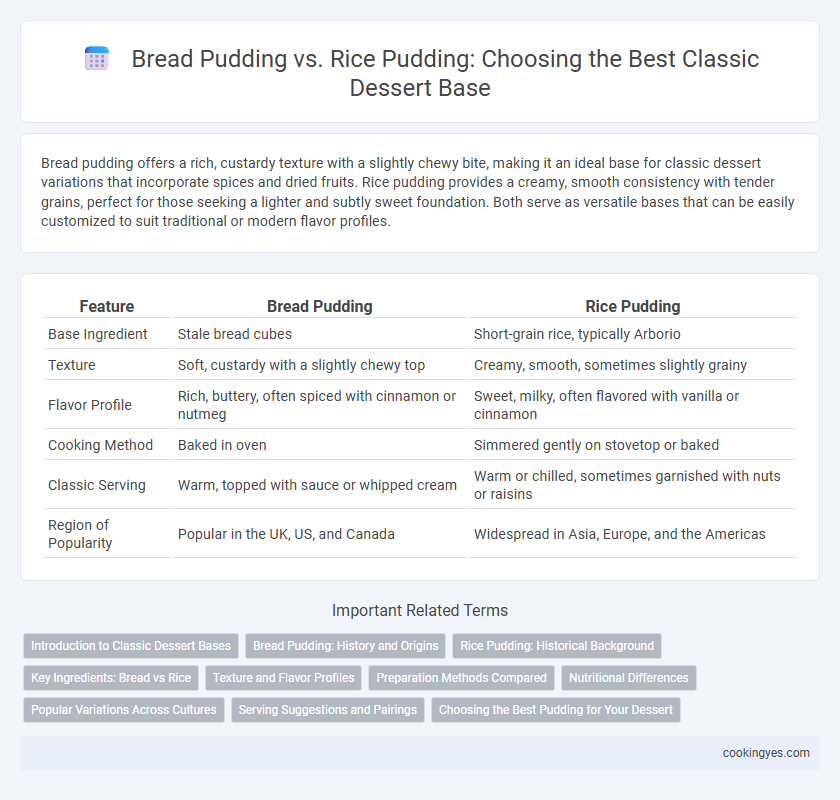Bread pudding offers a rich, custardy texture with a slightly chewy bite, making it an ideal base for classic dessert variations that incorporate spices and dried fruits. Rice pudding provides a creamy, smooth consistency with tender grains, perfect for those seeking a lighter and subtly sweet foundation. Both serve as versatile bases that can be easily customized to suit traditional or modern flavor profiles.
Table of Comparison
| Feature | Bread Pudding | Rice Pudding |
|---|---|---|
| Base Ingredient | Stale bread cubes | Short-grain rice, typically Arborio |
| Texture | Soft, custardy with a slightly chewy top | Creamy, smooth, sometimes slightly grainy |
| Flavor Profile | Rich, buttery, often spiced with cinnamon or nutmeg | Sweet, milky, often flavored with vanilla or cinnamon |
| Cooking Method | Baked in oven | Simmered gently on stovetop or baked |
| Classic Serving | Warm, topped with sauce or whipped cream | Warm or chilled, sometimes garnished with nuts or raisins |
| Region of Popularity | Popular in the UK, US, and Canada | Widespread in Asia, Europe, and the Americas |
Introduction to Classic Dessert Bases
Bread pudding and rice pudding serve as foundational bases in classic dessert recipes, each offering distinct textures and flavors that define traditional sweet dishes. Bread pudding provides a hearty, custard-soaked texture from stale bread, while rice pudding features creamy consistency achieved by simmering rice with milk and sugar. Both options create versatile canvases enriched by spices, fruits, and sauces to elevate their indulgent appeal.
Bread Pudding: History and Origins
Bread pudding, a classic dessert with origins dating back to medieval Europe, was traditionally made to utilize stale bread and avoid waste. Its history traces to English versions where bread was soaked in milk, eggs, spices, and sugar before baking, creating a rich, comforting dish. The use of bread as a base distinguishes it from rice pudding, which evolved independently with a focus on grains cooked in milk, reflecting different cultural and ingredient availability.
Rice Pudding: Historical Background
Rice pudding, a dessert with ancient origins, dates back to medieval times when rice was introduced to Europe through trade routes. This classic dish evolved across cultures, blending rice with milk, sugar, and spices like cinnamon or cardamom to create a creamy, comforting base. Compared to bread pudding, which uses stale bread soaked in custard, rice pudding's smooth texture and adaptability made it a staple in both Middle Eastern and Asian cuisines.
Key Ingredients: Bread vs Rice
Bread pudding features cubed bread soaked in a rich custard made from eggs, milk, and sugar, creating a dense and textured dessert. Rice pudding uses cooked rice simmered in milk and sweetened, resulting in a creamy, smooth consistency. The choice of bread or rice as the base significantly impacts the pudding's texture, flavor absorption, and overall mouthfeel.
Texture and Flavor Profiles
Bread pudding offers a dense, custard-soaked texture with a rich, buttery flavor that absorbs spices like cinnamon and nutmeg, creating a warm, comforting dessert. Rice pudding features a creamy, slightly chewy texture thanks to the tender grains, paired with subtle vanilla and milk-infused sweetness that provides a lighter, soothing taste. Both desserts excel as classic bases, with bread pudding delivering a hearty bite and rice pudding emphasizing smooth, delicate mouthfeel.
Preparation Methods Compared
Bread pudding requires soaking stale bread in a custard mixture of eggs, milk, sugar, and spices before baking, resulting in a dense and rich texture. Rice pudding involves simmering rice directly in milk or cream with sugar and flavorings, creating a creamy and smooth consistency. The preparation of bread pudding emphasizes absorbing the custard, while rice pudding centers on cooking rice until tender and creamy.
Nutritional Differences
Bread pudding typically contains more calories and carbohydrates due to the higher starch content in bread, while rice pudding offers a modestly lower glycemic index, making it a preferable option for blood sugar management. Rice pudding often provides a higher amount of essential minerals such as manganese and magnesium owing to the rice base. Both desserts can be rich in protein and calcium when made with milk and eggs, but the choice between bread and rice pudding depends on individual nutritional goals like calorie control or mineral intake.
Popular Variations Across Cultures
Bread pudding, a classic dessert base, features cubes of stale bread soaked in a mixture of milk, eggs, sugar, and spices, commonly found across British and American cuisines with variations including raisins or bourbon. Rice pudding, made from rice simmered in milk and sweetened with sugar, cinnamon, and sometimes cardamom, holds prominence in Asian, Middle Eastern, and Latin American cultures with diverse toppings like nuts, dried fruits, or rose water. Both puddings showcase cultural adaptation and regional flavors, reflecting widespread popularity through their comforting textures and sweet, rich profiles.
Serving Suggestions and Pairings
Bread pudding, often enriched with custard and baked with spices like cinnamon and nutmeg, pairs exceptionally well with warm caramel sauce or a dollop of whipped cream, enhancing its rich, comforting texture. Rice pudding, known for its creamy consistency and subtle sweetness, complements flavors such as fresh berries, toasted nuts, or a sprinkle of ground cardamom for an aromatic twist. Both classic dessert bases serve as versatile canvases for toppings that elevate their traditional profiles, making them perfect for customizable sweet endings.
Choosing the Best Pudding for Your Dessert
Bread pudding offers a dense, custardy texture with a rich, buttery flavor ideal for warm, comforting desserts, while rice pudding provides a creamy, smooth consistency with a subtle sweetness perfect for lighter, refreshing treats. Selecting between bread pudding and rice pudding depends on your preference for texture and flavor intensity, as well as the type of toppings or spices you wish to incorporate, such as cinnamon or nutmeg. Considering the dessert pairing and occasion, bread pudding pairs well with robust sauces like caramel, whereas rice pudding complements fresh fruit or floral essences for a delicate finish.
Bread pudding vs Rice pudding for classic dessert base Infographic

 cookingyes.com
cookingyes.com